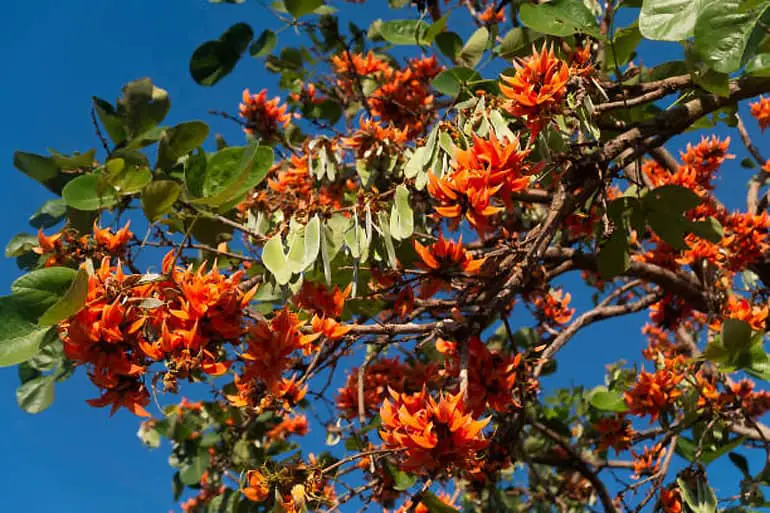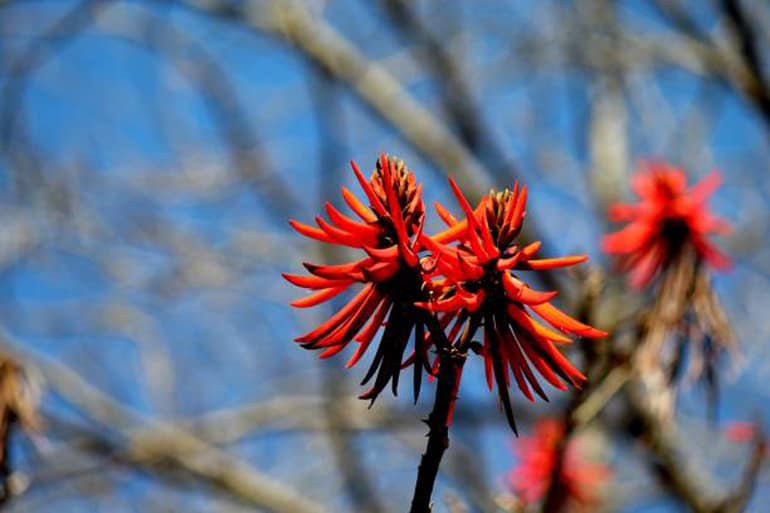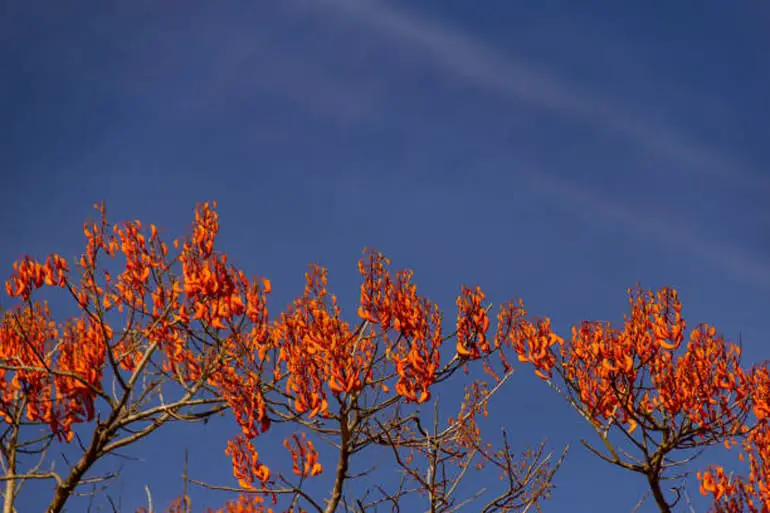Table of Contents
Coral Bonsai is a deciduous tree native to South Africa and South America. It belongs to the legume family – Fabaceae and there are about 130 species of the tree around the world with most of them highly populated among the subtropical and tropical regions.
If grown on a landscape, the Coral tree can grow as tall as 45 ft, but if trained as Bonsai, it can be trimmed to about 12ft. The tree can be uniquely identified with its spectacle of flowers with colors ranging from pink to red or orange.
Training a Coral tree as Bonsai can be a bit challenging especially for young horticulturists with little experience with the tradition because it is a slow-growing plant. However, do not be discouraged because here in this article, you will learn all you need to know about training a Coral Bonsai tree right from germination to the maturity stage as well as other interesting facts about the tree. Keep reading for details.
General information
| Scientific name | Erythrina fuscus |
| Country of origin | Central South America |
| Family | Fabaceae |
| Type | Tree |
| Zone | 9 to 11 |
| Bloom description | Crimson Red |
| Blooming period | April to October |
| Flower color | Red, orange, or pink |
| Height | 15 to 20ft |
| Wide | 10 to 15ft |
| Sun | Full sun |
| Water | Medium |
| Fertilizer | Moderate fertilizer |
| Maintenance | Low |
| Flower | Showy |
| Fruit | Showy |
Can we Bonsai Coral tree

Yes, you can Bonsai Coral tree. You can train a coral tree as bonsai and trust me, they will turn out to be beautiful and powerful Bonsai. If you would like to explore the Bonsai tradition with coral trees, make use of the dwarf coral variant. It is believed to be the best Coral tree species for Bonsai practice. However, before they are successfully cultivated, you have to be extremely patient because Coral Bonsai exhibits a slow growth rate and you may be discouraged at first if the tree fails to grow as expected. Coral trees trained as Bonsai can be distinguished by their robust and lack of fine branch ramification.
Coral tree Bonsai history
Unfortunately, there’s not much information about the history of Coral tree Bonsai. All that is available about the tree is that it is native to South America and South Africa.
Coral Bonsai scientific name

The scientific name of Coral Bonsai is Erythrina fusca
Coral tree Bonsai care
Even though the coral tree is a slow-growing tree, it is very easy to train as Bonsai. However, your success is heavily dependent on how willing or how easy it is for you to keep up with its care requirements. Detailed explained below are some of the treatments required for a Coral Bonsai tree to stay healthy throughout its growing stage.
Coral Bonsai temperature
Coral Bonsai can not handle extreme or very low temperatures. They must be raised under a moderate level of temperature to survive. When Coral is at the growth stage, make sure it is exposed to sunlight for only about 5 to 6 hours, and once you notice the outdoor temperature is higher than 35°C, share it or take it inside. The standard temperature for a Coral Bonsai tree is between 22 – 26°c.
Coral Bonsai fertilizer
You don’t need to overfeed Coral Bonsai fertilizers before they can be successfully cultivated. All you need to do is apply a mulch of compost around the root occasionally during spring once you notice that flowers are starting to bloom out of the new branches in the current season. The mulch will provide just the needed nutrients to the plant.
Coral Bonsai pruning
Although coral bonsai have robust branches, its new shoots are very easy to shape. The shoots grow pretty fast and therefore, one has to be careful because shaping them with wires can cause large scars on the branches.
Coral Bonsai should be pruned once a year and should be done during spring just after it blooms so that you don’t end up interrupting its blooming cycle. You can also prune the tree any time of the year once you notice imbalance growth. Trim stems that look heavier than the other and cut off damaged parts. Trim off green growth as they contain excess water, and they can cause softwoods to fall off the tree.
Coral Bonsai repotting
The root of the Coral tree Bonsai needs to be reported at least every 2 years because of the rapid growth of its root system. This will ensure that the root does not outgrow its restricted space within the pot. If you leave the root of a Coral tree Bonsai unpotted when necessary, it will continue to hold more water and little oxygen which will lead to retarded growth and root rot. If appropriate steps are not taken to correct the abnormality, your tree may deteriorate and eventually die.
The best time to repot your Coral Bonsai is during spring right after it is coming out of its dormant period. One good thing about repotting a Coral Bonsai is that it can tolerate heavy running therefore, feel free to prune the balls if necessary and cut down the long thick root to encourage healthy growth and make sure to cover the root with enough soil. If the soil is not enough to hold the tree down, you can make use of wires to secure it inside the pot.
Coral Bonsai pests and diseases
The Coral Bonsai tree is vulnerable to most diseases that are common to other Bonsai trees like aphids and spider mites. However, Coral Bonsai is mostly affected by Erythrina Gall Wasp, an insect notorious for laying eggs under the leaved coral trees. Although they wouldn’t cause fatal damage to the tree, however, they can make the tree look warty.
The Aphid is known for sucking nutrients that are crucial for the survival of the tree off the leaves and stems, which may cause them to look completely unhealthy which can be easily noticed from the spots on the tree leaves. Another insect that is commonly seen on Coral trees is spider mites. These insects focus on one thing, sucking off chlorophyll from the leaves of the tree. What makes these insects super dangerous is that they multiply pretty fast because they can survive under any condition whether dry or hot.
Another insect worthy of mentioning is the Erythrina stem Borer which commonly occurs when the trunk of the tree is overly wet. This insect feeds on the outer cambium of the tree’s bark and causes them to rot.
Fortunate enough, all these infections can be prevented by making sure to wash down your tree with enough water anytime you notice any infestation. However, you must take care not to get the tree overwatered to avoid likely consequences. Another way to control infestation is by spraying the tree with pesticide when needed below and over the tree leaves.
Coral Bonsai soil
For any Coral Bonsai species to survive, they must be planted in a well-draining, well-aerated, and fertile soil. Those qualities especially the well-draining soil is very crucial to prevent the tree from root and stem rot. These two infections can kill a Coral tree and therefore must be prevented at all costs.
To grow your Coral Bonsai, you can make use of the Bonsai soil mix that is sold in stores. Make sure to get one with loads of stones in them. These stones will ensure the circulation of air through the soil and that there’s a free flow of water to ensure proper draining. You can make holes or get pots with drainage holes to ensure that water drains fast and there’s enough air present in the soil.
Coral Bonsai watering
Coral trees are highly drought tolerant and only need little water to survive. Usually, the pot which houses Coral Bonsai is shallow, and therefore, you must see to it that the soil does not completely dry out. To ensure that the tree retains enough water, add a layer of moss to the soil during winter and summer. Ensure that the tree is adequately watered during summer and is kept dry during winter. If you are cultivating your Coral Bonsai outdoors in places where rain falls during winter, always ensure that the soil is draining well to protect the tree from root rot.
Coral Bonsai Sunlight
The coral tree will survive in warm and frost-free regions and benefits more from exposure to full sunlight. Once the tree matures, it can tolerate moderate cold however, younger Coral trees need to be protected for several years from being exposed to cold. Place your tree where it can receive enough sunlight daily and make sure it is protected from cold during winter nights.
Coral Bonsai propagation
Coral Bonsai can be cultivated in 3 major ways, through the seeds, cuttings, and truncheons. Each of these methods is very effective, but each has an accompanying setback.
If you propagate the Coral tree by seed, it will take longer to see the result. On the other hand propagation by cuttings may be faster but has the highest chance of rotting away. Truncheon is considered the best method of propagating Coral trees because it has the highest rate of success.
Coral Bonsai types

As said earlier, there are about 130 species of Coral tree, however, not all of them are used for Bonsai practice. Provided below is information about the few types that are commonly used for Bonsai.
Erythrina caffra Bonsai
The Erythrina caffra Bonsai known as Costal coral is a tropical Coral tree species that is also being to the legume family, Fabaceae. It can be easily identified with its rich vibrant colors ranging from pink to red and orange. It can grow up to about 65ft long with a crown spread of about 80fts.
Erythrina lysistemon Bonsai
Erythrina lysistemon is a very common Coral tree species that can be found in South Africa. Although not commonly used for Bonsai, when used, they usually grow into a very beautiful Bonsai tree. They require a lot of suns and a moderate amount of water to survive and hold pretty much every other quality of the Coral tree species.
Erythrina crista-Galli Bonsai
Erythrina crista-galli popularly known as the cockspur Coral tree is a flowery plant that belongs to the Fabaceae family and is native to many countries, including Uruguay, South Brazil, Paraguay, and Argentina. They are naturally small trees that can only grow up to about 50cm tall. It has a tap root system that produces nodules through nitrogen-fixing bacteria.
Erythrina variegata Bonsai
Erythrina Variegata is a Coral tree species that belongs to the Erythrina genus. The tree is classified as a climbing herb and can grow up to about 6m and has leaves with petioles that can spread about 5 to 6 cm wide. It is known for its edible leaves, flower, and pods which are cooked as vegetables.
Is Coral Bonsai toxic to cats
Yes, Coral Bonsai is toxic to cats. Coral trees produce a toxic substance that has a curare-like and paralyzing effect. Although it can be used for medicinal purposes, it can impact negatively on the health of your cat.
How to Bonsai Erythrina plant from seed
Well, we’ve already covered pretty much everything that is involved in raising a Coral Bonsai and briefed on how it can be propagated. Here, you will be informed duly on how you can propagate Coral Bonsai from seed. Check below for details.
- Place the seeds on the prepared Bonsai soil, making sure to leave spaces between them.
- Make sure that you have at least 20 seeds per pot.
- Cover the seed with the recommended soil.
- Press the soil lightly with your fingers to compact the soil.
- Wet the soil with enough water and make it drains through the pot drainage holes and keep it moisturized from that point on.
- Place the pot in a location where it can receive direct sunlight.
- Keep up with its required maintenance like lighting and watering until it germinates.
Can I Bonsai Coral tree indoors
You don’t have to so worry about your Coral Bonsai placement because they can be trained both indoors and outdoor. However, since Coral is both a tropical and subtropical plant, it will prefer indoors since the temperature will be stable thought the year.
![Pittosporum Bonsai [Pittosporum Tobira]](https://www.bonsai-express.com/wp-content/uploads/2022/05/Pittosporum-Bonsai-365x200.jpg)
![Sorbus Bonsai [Sorbus Aucuparia]](https://www.bonsai-express.com/wp-content/uploads/2022/05/Sorbus-Bonsai-365x200.jpg)
![Tsuga Bonsai [Tsuga Canadensis]](https://www.bonsai-express.com/wp-content/uploads/2022/05/Tsuga-Bonsai-365x200.jpg)
![Tamarix Bonsai [Tamarix Ramosissima]](https://www.bonsai-express.com/wp-content/uploads/2022/05/Tamarix-Bonsai-365x200.jpg)